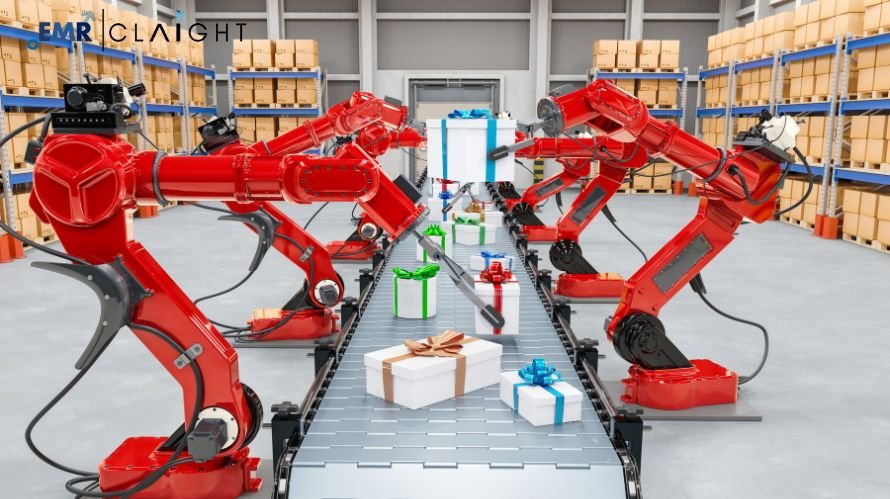The warehouse robotics market is experiencing a remarkable transformation as industries seek to optimize their supply chains and logistics operations. With the growing need for enhanced efficiency, accuracy, and cost reduction in warehouses, automation technology, specifically robotics, is playing an increasingly critical role. Warehouse robotics involves the use of automated systems, including robots and software, to streamline the process of storing, retrieving, and organizing products within a warehouse setting. These robotic systems include automated guided vehicles (AGVs), robotic arms, and autonomous mobile robots (AMRs), all of which are designed to perform repetitive, labor-intensive tasks. This technological revolution is reshaping the logistics sector, making operations faster, safer, and more efficient. As a result, the warehouse robotics market has witnessed significant growth over recent years and is poised to continue its upward trajectory in the coming decades. The warehouse robotics market size reached around USD 8.57 Billion in 2024. The market is projected to grow at a CAGR of 14.20% between 2025 and 2034 to reach nearly USD 32.33 Billion by 2034. This projected growth underscores the growing importance of robotics in warehouses, as companies strive to meet the increasing demand for faster delivery times, higher accuracy in inventory management, and lower operational costs. The adoption of warehouse robotics is driven by various factors, including the rise of e-commerce, the need for improved labor efficiency, and the ongoing advancements in artificial intelligence (AI) and machine learning (ML). As we delve deeper into the various facets of the warehouse robotics market, it becomes evident that this market is a key enabler of the future of logistics and supply chain management.
The Growth of E-commerce and its Impact on Warehouse Robotics
One of the primary drivers of the warehouse robotics market is the exponential growth of e-commerce. The e-commerce industry has seen a meteoric rise in recent years, with consumers increasingly demanding faster and more accurate deliveries. This surge in demand has placed tremendous pressure on traditional warehouses to adapt quickly and efficiently. Robotics, with its ability to automate tedious and time-consuming tasks, offers a solution to these challenges. Automated systems can swiftly sort, pick, and pack products, reducing the time it takes to process orders and ensuring that products are shipped out more efficiently.
As e-commerce companies strive to maintain competitive delivery times, warehouse robotics has become a critical part of their operations. In particular, robots are used for order picking, which is one of the most labor-intensive tasks in a warehouse. Robotic systems are capable of navigating through warehouse aisles, picking items from shelves, and delivering them to packaging stations with remarkable speed and accuracy. This capability allows e-commerce businesses to fulfill orders more quickly, reducing the time between order placement and delivery.
The integration of robotic systems in warehouses also helps to improve inventory management. Traditional inventory management relies heavily on human workers to manually track and organize products, which can be prone to errors and inefficiencies. In contrast, warehouse robotics systems equipped with sensors, AI, and machine learning algorithms can monitor stock levels in real-time, predict demand trends, and ensure that inventory is maintained at optimal levels. This reduces the likelihood of stockouts or overstocking, which can lead to unnecessary costs.
Get Instant Access to Your Free Report Sample
Types of Robotics in Warehouse Operations
Warehouse robotics encompasses a variety of technologies that perform different tasks within the warehouse environment. Some of the most commonly used types of robots in warehouse operations include automated guided vehicles (AGVs), autonomous mobile robots (AMRs), robotic arms, and robotic sorting systems. Each of these robotic systems serves a specific purpose, and their adoption depends on the needs of the warehouse.
- Automated Guided Vehicles (AGVs): These are mobile robots that follow predefined paths or tracks within the warehouse. AGVs are primarily used for material handling, transporting goods from one area of the warehouse to another. They are equipped with sensors and cameras that allow them to avoid obstacles and navigate safely through the warehouse. AGVs are often used for tasks such as moving pallets, large boxes, or bulky items that are too heavy for human workers to carry manually.
- Autonomous Mobile Robots (AMRs): AMRs are more advanced than AGVs in that they are capable of navigating autonomously without the need for predefined tracks or paths. They use advanced sensors, AI, and machine learning algorithms to interpret their surroundings and navigate through dynamic environments. AMRs are versatile and can be used for various tasks, such as order picking, inventory management, and even last-mile delivery. Their ability to navigate freely within the warehouse makes them an ideal solution for warehouses that need flexible, adaptive systems.
- Robotic Arms: Robotic arms are used in a wide range of warehouse applications, particularly in tasks that require precision and dexterity. These robots are commonly used for picking, sorting, and packaging items. Robotic arms can be programmed to handle different shapes and sizes of products, making them ideal for warehouses that store a variety of items. Additionally, robotic arms can be integrated with AI systems to enhance their decision-making capabilities, allowing them to identify and handle products with greater accuracy.
- Robotic Sorting Systems: These systems are designed to automatically sort products based on predefined criteria, such as size, shape, or destination. Robotic sorting systems are commonly used in large distribution centers where a high volume of packages needs to be processed quickly. These robots can sort items with great speed and accuracy, improving the overall efficiency of the warehouse and reducing the likelihood of human error.
Technological Advancements Driving the Warehouse Robotics Market
The rapid advancements in AI, machine learning, and sensor technologies have played a pivotal role in the growth of the warehouse robotics market. These technologies are enabling robots to perform more complex tasks, making them increasingly adaptable to various warehouse environments. AI-powered robotics systems can learn from their surroundings, adjust their behavior based on real-time data, and even collaborate with human workers in a shared workspace.
Machine learning algorithms allow robotic systems to improve their performance over time. For example, a robotic arm equipped with a machine learning algorithm can become more efficient at picking and sorting products as it gains experience. Similarly, AMRs can learn the optimal routes for navigating a warehouse, allowing them to move more quickly and efficiently.
In addition to AI and machine learning, advancements in sensor technologies are also enhancing the capabilities of warehouse robots. Sensors such as LiDAR, ultrasonic sensors, and cameras allow robots to perceive their environment and make real-time decisions. These sensors enable robots to avoid obstacles, navigate through complex environments, and even collaborate with other robots in a coordinated manner. The integration of advanced sensors with AI systems is making warehouse robotics more reliable and effective in various applications.
Benefits of Warehouse Robotics
The adoption of warehouse robotics offers numerous benefits to businesses, ranging from cost savings to improved safety. Some of the key advantages include:
- Increased Efficiency: Robots can perform tasks faster and more accurately than humans, leading to higher throughput in warehouse operations. Automated systems can work around the clock without the need for breaks, ensuring that tasks are completed quickly and consistently.
- Cost Reduction: Although the initial investment in warehouse robotics can be high, the long-term cost savings are substantial. Robots reduce the need for manual labor, which can result in significant savings in labor costs. Additionally, robots can reduce errors, minimizing the costs associated with inventory discrepancies or shipping mistakes.
- Improved Safety: Warehouse environments can be hazardous, particularly when workers are required to perform physically demanding tasks. By automating these tasks, robots can reduce the risk of workplace injuries. For example, robots can handle heavy lifting, reducing the strain on human workers and lowering the likelihood of musculoskeletal injuries.
- Scalability: As businesses grow and demand increases, the scalability of warehouse robotics systems becomes a major advantage. Robotics systems can be easily scaled up to accommodate higher volumes of goods without the need to significantly expand the workforce. This flexibility allows businesses to adapt to changing market conditions more effectively.
- Enhanced Accuracy: Robots equipped with AI and sensor technologies can perform tasks with exceptional precision, reducing the risk of errors in picking, sorting, and inventory management. This accuracy is particularly important in industries such as pharmaceuticals or electronics, where product specifications must be strictly adhered to.
Challenges and Limitations
While the warehouse robotics market offers a wide range of benefits, it also presents certain challenges and limitations. One of the primary concerns is the high upfront cost of implementing robotic systems. Small and medium-sized businesses may find it difficult to justify the investment in automation technology, particularly if they have limited budgets.
Another challenge is the integration of robotics into existing warehouse infrastructure. Many warehouses are not designed to accommodate automated systems, and retrofitting them to support robotics can be a complex and costly process. Additionally, the implementation of robotics requires skilled labor to manage and maintain the systems, which may require significant training or the hiring of specialized personnel.
There are also concerns about the potential displacement of human workers. While warehouse robotics can reduce the need for manual labor in certain tasks, it is important to note that the technology is more likely to augment human workers rather than replace them entirely. In many cases, robots can handle repetitive, physically demanding tasks, allowing human workers to focus on more complex and value-added activities.
The Future of the Warehouse Robotics Market
The future of the warehouse robotics market looks incredibly promising, with advancements in AI, machine learning, and sensor technologies continuing to drive innovation. As the demand for faster, more efficient supply chains grows, the adoption of robotics is expected to become more widespread across industries. Warehouse robotics will continue to evolve, becoming more intelligent, autonomous, and cost-effective, further revolutionizing the logistics and supply chain industries.
the warehouse robotics market is on a rapid growth trajectory, driven by factors such as the rise of e-commerce, advancements in technology, and the increasing demand for efficiency in warehouse operations. With the market projected to grow at a CAGR of 14.20% between 2025 and 2034, reaching nearly USD 32.33 Billion by 2034, the role of robotics in supply chains and logistics will only continue to expand. As businesses seek to remain competitive in an ever-evolving marketplace, the integration of robotics into warehouse operations will play a pivotal role in shaping the future of logistics and supply chain management.
Media Contact
Company Name: Claight Corporation
Contact Person: Chander Deep, Corporate Sales Specialist
Email: sales@expertmarketresearch.com
Toll Free Number: +1–415–325–5166 | +44–702–402–5790
Address: 30 North Gould Street, Sheridan, WY 82801, USA
Website: www.expertmarketresearch.com


